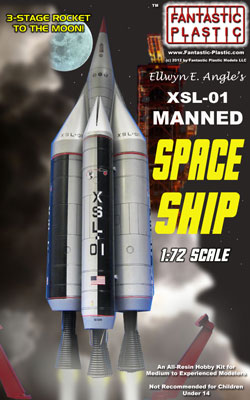For Fantastic Plastic, a 1/48 scale “Hydra Parasit” from Captain America.
Another photo showing the insulation applied to the outside of the F-1 rocket engine during launch. So far as I’m aware, not a single model or toy of the Saturn V launch vehicle has ever depicted this.
See HERE for more.
Another CAD model I’ve been tinkering with is a Convair “Triamese” space shuttle concept. If it were to be turned into a kit, the parts would include the wings either retracted or deployed… due to the difficulty in making the numerous little hinged doors actually work in practice, making a truly VG model would be impractical.
Most of the 3D solid models I’ve made, I’ve made for clients or employers. Every now and then, though, I’ve made a few on spec or just for giggles. One such is the Convair Super Hustler. It’s nowhere near done, but it at least looks like a Super Hustler. When done, I hope to translate it into physical form, either as a kit or as a finished display model.
The booster stage will of course be modeled as well. The B-58 Hustler carrier aircraft is available in 1/144, 1/72 and 1/48 scales… but damn, the Super Hustler would be impressive at 1/18 scale!
Another display model, this time showing a three-engined design with a 727-style tail engine and Upper Surface Blown engines above the wings. This would have been quieter on the ground and would have required a shorter runway. But as the 727 discovered, re-engining to a higher bypass engine would have been troublesome in the tail.
Now in production, and in a Man’s Scale… 1/72, not the original 1/96 scale.
XSL-01 Moon Rocket

In the early-mid 1970’s, Boeing was looking towards a new generation of wide-body jetliner to replace their older planes such as the 707 and 727. Initially designated “7X7,” it eventually became the 767. Along the way, a wide range of unusual layouts were studied, a number of which were built… at least as display models.
This concept called for four turbofan engines mounted above the wing. This would add two features:
1) It would be quieter, since some of the noise from the exhaust would be shielded from the ground by the wings (though potentially louder in the cabin)
2) The Upper Surface Blowing configuration creates additional lift at low speed due to the Coanda Effect.
On the other hand, having the exhaust scraping directly along the wing surface would create additional stresses as well as reducing thrust at high speed. Additionally, a configuration like this would be difficult to re-engine later with higher bypass engines.
VSP is a CAD program used by NASA for rapid preliminary design. Until recently it was available to the public on a limited basis… had to sign licensing forms, no further redistribution… and no release to non-US nationals.
OpenVSP is a parametric aircraft geometry tool. OpenVSP allows the user to create a 3D model of an aircraft defined by common engineering parameters.
It’s now been released for general consumption. I’ve not used it, but it’s reportedly very easy to learn and use, and is designed for preliminary conceptual aircraft design. I’m told that it does well at creating watertight meshes, and outputs in a Rhino format.
OpenVSP
An AIAA paper describing VSP is here: Aircraft Conceptual Design Using Vehicle Sketch Pad
Sadly, I don’t see a big fat collection of actual NASA-produced conceptual aircraft designs for downloading, but I suppose some of them will make it out at some point.
www.openvsp.org









